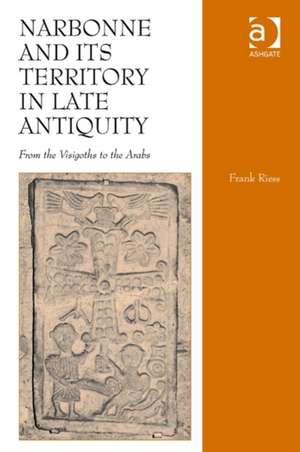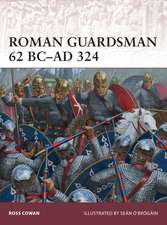Narbonne and its Territory in Late Antiquity: From the Visigoths to the Arabs
Autor Frank Riessen Limba Engleză Hardback – 31 oct 2013
| Toate formatele și edițiile | Preț | Express |
|---|---|---|
| Paperback (1) | 388.72 lei 43-57 zile | |
| Taylor & Francis – 12 dec 2019 | 388.72 lei 43-57 zile | |
| Hardback (1) | 864.57 lei 22-36 zile | |
| Taylor & Francis – 31 oct 2013 | 864.57 lei 22-36 zile |
Preț: 864.57 lei
Preț vechi: 1054.36 lei
-18% Nou
Puncte Express: 1297
Preț estimativ în valută:
165.49€ • 179.82$ • 139.10£
165.49€ • 179.82$ • 139.10£
Carte disponibilă
Livrare economică 31 martie-14 aprilie
Preluare comenzi: 021 569.72.76
Specificații
ISBN-13: 9781409455349
ISBN-10: 1409455343
Pagini: 304
Dimensiuni: 156 x 234 x 22 mm
Greutate: 0.54 kg
Ediția:New.
Editura: Taylor & Francis
Colecția Routledge
Locul publicării:Oxford, United Kingdom
ISBN-10: 1409455343
Pagini: 304
Dimensiuni: 156 x 234 x 22 mm
Greutate: 0.54 kg
Ediția:New.
Editura: Taylor & Francis
Colecția Routledge
Locul publicării:Oxford, United Kingdom
Cuprins
Narbonne and the Roman world of the 4th century. Christian and Classical histories of Narbonne. Sidonius and the passing of Roman Narbonne. The Visigothic kingdom: from Liuva I to Reccared. The North-east and the territory of Narbonne. Rebellion on the border: the Regnum Orientalis. The Arabs and the fall of Narbonne. The first and last city.
Notă biografică
Frank Riess is an Honorary Research Fellow at Birkbeck College, London, UK.
Recenzii
'...Riess monograph exhibits the virtues of a regionalist approach while, at the same time, persuasively arguing for Narbonnes relevance to the greater political, military, and diplomatic affairs of the post-Roman Mediterranean world.' Bryn Mawr Classical Review 'Riess excites with the interplay of textual and material evidence. Valuable and informative set pieces result; examples include an investigation of the location of Sulpicius Severus’s retreat, Primuliacum (pp. 66-69); analysis of Narbonne’s Christian origins (pp. 115-17); and examination of Narbonne’s hinterland in light of recent archeological categorizations for rural settlements (pp. 194-203). In sum Riess’s book exemplifies the outstanding scholarship one can achieve by mastering the intertwining of textual and archaeological evidence.’ Journal of Late Antiquity '... thoroughly impressive ... Riess persuasively argues that the region of Narbonne was integral to events ranging across Hispania and was in turn shaped by events in an even wider political theatre that involved Visigothic, Frankish, Burgundian, Ostrogothic, Byzantine and Arab interests.' H-France Review
Descriere
This work centres on the post-Roman period of Narbonne and its territory, up to its capture by the Arabs in 720, encompassing not only recent archaeological findings but also perspectives of French, Spanish and Catalan historiography that have fashioned distinct national narratives. Seeking to remove Narbonne from any subsequent birth of France, Catalonia and Spain, the book presents a geopolitical region that took shape from the late fifth century, evolving towards the end of the eighth century into an autonomous province of the nascent Carolingian Empire.










